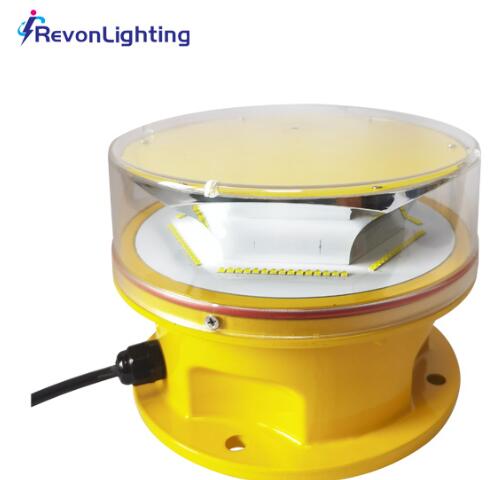Posted: 2024-06-21
Obstruction warning lights play a crucial role in ensuring safety in various environments, including aviation, maritime, construction, and urban settings. These lights are designed to mark and signal the presence of potential hazards, helping to prevent accidents and protect both people and property. This article explores the importance of obstruction warning lights, their applications, types, and the regulations governing their use.
Importance of Obstruction Warning Lights
Safety is the paramount concern in any environment where there is potential for accidents. Obstruction warning lights serve as an early warning system, alerting individuals to the presence of obstacles that might not be immediately visible, especially in low visibility conditions such as fog, rain, or darkness. These lights are particularly vital in the following scenarios:
Aviation Safety: Tall structures like towers, buildings, and wind turbines can pose significant hazards to low-flying aircraft. Obstruction warning lights help pilots navigate safely, reducing the risk of collisions. According to the Federal Aviation Administration (FAA), any structure over 200 feet above ground level must be marked with appropriate lighting to ensure it is visible to aircraft.
Maritime Navigation: In the maritime environment, obstruction lights are used to mark the presence of buoys, piers, and other hazards in the water. These lights are crucial for the safe navigation of ships, especially during nighttime or in poor weather conditions.
Construction Sites: Construction sites often have heavy machinery, cranes, and unfinished structures that can pose risks to workers and passersby. Obstruction warning lights help in highlighting these dangers, thus preventing accidents and ensuring a safer working environment.
Urban Areas: In cities, obstruction lights are used to mark areas where maintenance work is being carried out, roadblocks, and other potential hazards. These lights help drivers and pedestrians avoid accidents and navigate safely through the urban landscape.
Types of Obstruction Warning Lights
Obstruction warning lights come in various types, each suited for different applications and environments. The primary types include:
Low-Intensity Lights: These are used for structures that are relatively low in height, typically less than 200 feet. They are usually red or white and are used to mark small buildings, antennas, and other low-rise structures.
Medium-Intensity Lights: These lights are used for taller structures and can be seen from greater distances. They are often white during the day and red at night, providing continuous visibility.

High-Intensity Lights: These are used for very tall structures, such as communication towers and skyscrapers. They are extremely bright and can be seen from miles away, ensuring that pilots and other individuals are aware of these potential hazards.
Solar-Powered Lights: In remote areas where access to electricity is limited, solar-powered obstruction lights provide a sustainable and reliable option. These lights are equipped with solar panels and batteries, ensuring they remain operational even during power outages.
LED Lights: LED technology has revolutionized obstruction lighting, offering longer lifespan, higher energy efficiency, and greater visibility compared to traditional incandescent lights. LEDs are now commonly used in all types of obstruction warning lights.
Regulations and Standards
The implementation of obstruction warning lights is governed by various international and national standards to ensure consistency and reliability. Key regulatory bodies include:
Federal Aviation Administration (FAA): In the United States, the FAA provides guidelines for the marking and lighting of structures that could pose a hazard to air navigation. These guidelines are detailed in the FAA Advisory Circular AC 70/7460-1L.
International Civil Aviation Organization (ICAO): ICAO sets global standards for the marking and lighting of obstacles to air navigation. These standards are outlined in Annex 14 to the Convention on International Civil Aviation.
International Association of Lighthouse Authorities (IALA): IALA sets guidelines for marine navigation aids, including the use of obstruction lights on buoys, lighthouses, and other maritime structures.
| Obstruction warning lights | LI |
| MI | HI |
| HI-A |
National Standards: Many countries have their own regulations and standards for obstruction lighting. For instance, the UK Civil Aviation Authority (CAA) has guidelines similar to the FAA for the marking of obstacles.
Challenges and Future Directions
While the current systems for obstruction warning lights are effective, there are challenges and areas for improvement:
Technological Advancements: Continuous innovation in LED technology, battery efficiency, and solar power can further enhance the performance and reliability of obstruction lights.
Integration with Smart Systems: Integrating obstruction lights with smart city infrastructure and Internet of Things (IoT) technology can allow for real-time monitoring and maintenance, ensuring lights are always operational and providing timely alerts when they need servicing.
Environmental Impact: Ensuring that obstruction lights do not contribute to light pollution and are designed to minimize their impact on local wildlife is an ongoing concern. Solutions such as dimming capabilities and shielding can help mitigate these effects.
Conclusion
Obstruction warning lights are a vital component of safety systems across various industries. Their role in preventing accidents and ensuring safe navigation cannot be overstated. As technology advances, these lights will become even more effective and efficient, further enhancing safety standards. Regulatory bodies must continue to update and enforce guidelines to ensure that these systems provide the maximum possible protection.